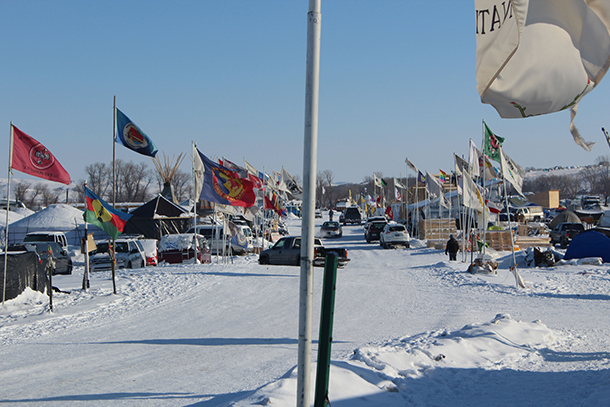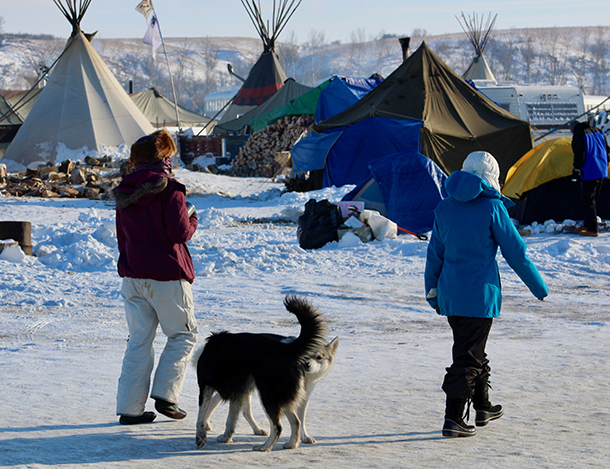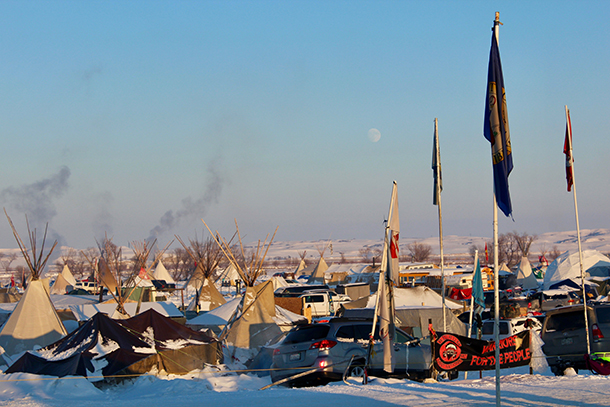Standing Down at Standing Rock
Air Date: Week of February 3, 2017

Though many are making plans to leave, others have vowed to remain at the Standing Rock Sioux Campground even as President Trump’s Executive order makes halting the pipeline construction more difficult. (Photo: Joe Brusky CC BY-NC 2.0)
Donald Trump's new executive order makes completing the Dakota Access Pipeline and building the Keystone XL pipeline more likely. Standing Rock Sioux leadership now wants DAPL protestors to go home. But many who opposed DAPL with the Native Americans in North Dakota for months are not ready to accept defeat. Reporter Sandy Tolan returned to the Standing Rock Camp to listen to the small band of “water protectors’ still braving the winter elements there and discusses the attitudes and developments with host Steve Curwood.
Transcript
CURWOOD: It’s Living on Earth, I’m Steve Curwood. Among the first actions of the Trump White House was an Executive Order to greenlight the building of the Keystone XL and Dakota Access oil pipelines. TransCanada has already filed a new application to get Keystone XL approved, but the final links of the Dakota Access pipeline, DAPL, are held up by an Environmental Impact Assessment required by the Army Corps of Engineers at the request of President Obama. For months, thousands of Native Americans and supporters stood shoulder to shoulder to protest plans to route this pipeline across lands held sacred and under a water source serving millions.
Now, reporter Sandy Tolan has returned to the Standing Rock camp to gauge reaction to the new developments with DAPL. Sandy, welcome. It can be rather cold on the northern plains. What’s the weather like at camp?

The flags lining Crazy Horse Avenue were still flying as of December when this photo was taken. (Photo: Jacqueline Keeler)
TOLAN: Yeah, it was very cold, although there was a thaw later in the week while I was there, but, Steve, pipeline supporters in Washington and in North Dakota are delighted that the Army Corps is about to give its approval to complete the pipeline by building the nearly last stretch under the Missouri River. As you remember it’s a nearly $4 billion project. It runs almost 1200 miles and would carry half a million barrels of crude oil a day from the Bakken oil patch in northwest North Dakota to a terminal in Illinois. After that it’ll go on toward the Gulf of Mexico. On Jan 31, North Dakota Rep. Kevin Cramer tweeted, “Start your engines. #DAPL #Approved,” and in a statement he said, “Got word from the White House today” that DAPL “has its final green light."
CURWOOD: So Sandy, how fair is it to say that the project, well is definitely going through?
TOLAN: It’s not necessarily the case, Steve. The Standing Rock Sioux Tribe, which along with tens of thousands of so-called “water protectors” have been battling this pipeline for months, issued a statement disparaging supporters statements as “premature”. It said the Army Corps lacks statutory authority to stop the Environmental Impact Statement, and the Tribe believes abandoning EIS would amount to what it called an “arbitrary change based on the President’s personal views and, potentially, his personal investments.” Chairman David Archambault added, basically, “See you in court.”
CURWOOD: And what about the protestors, the so-called water protectors? How many are still there, and how to they feel about it?
TOLAN: Well, the numbers are down, Steve, partly because of the winter holidays but also because it’s been so darn cold. There was a high of 10,000 people last summer. By some estimates, it’s down to less than a thousand now. They are hunkered down in teepees, yurts, military tents. On some nights it’s gotten to 18 below without the wind chill.
But the people I’ve talked to recently remain determined to stand against the pipeline. In recent days with the lower numbers, with President Trump’s attempts to fast track the process, it’s all added up to a lot of uncertainty and disagreement about how to stop the pipeline or even whether it can still be done. There’s a lot of worry about that. But there does remain a strong conviction to continue the fight, including from Linda Black Elk, she’s an ethnobotanist and professor at Sitting Bull College, and a camp medic.

By some estimates, the numbers at camp are down from nearly 10,000 to less than 1,000 now. (Photo: Jacqueline Keeler)
BLACK ELK: I'm just a mom, you know, and I am a mom and a teacher. And I never thought that I would have to say I might have to put my freedom or my life on the line to protect my
children's legacy, right? What I leave them, whether that is the water, the land, treaty rights, sacred sites, but I'm willing to do it.
TOLAN: I should add, Steve, that many of the water protectors now see the fight moving beyond Standing Rock, as a part of the broader struggle against President Trump. And yet there remains tension between some of the protestors and the Standing Rock tribe.
CURWOOD: Sandy, why is there tension at the point? What’s going on?
TOLAN: Well, despite the recent executive memo from President Trump, the Standing Rock Sioux tribe has asked the water protectors, those who aren’t from Standing Rock, which is the strong majority of them, to go home. This has brought a lot of tension and hurt feelings too. A lot of people have sacrificed a lot to come here, given up work, family, at the request of the tribe, and now only to be asked to leave at this critical moment.
From the tribe’s perspective, they’re the people who know this land the best. The main camp is in a flood plain, and within weeks the Missouri River will inundate the land. They know this from, you know, really, thousands of years. Crews are on location now to start the massive job of breaking down and cleaning up the camp, even as other groups try to mobilize folks to come back and fight the pipeline. So it’s a very confusing time, and things are really breaking down in the camp physically. I mean structures are coming down, all the while that people are talking about bringing others back. Some in the meantime say they’re going to head home. Others say, “No,” they don’t care, they’ll just head to higher ground, including this fellow, Joseph Hock, who’s a military veteran and a native man from Michigan.
HOCK: I don't plan on leaving. When the grandmothers and the matriarchs of the Standing Rock Nation ask me to leave, then I’ll leave. I’m staying. I’m here indefinitely.
CURWOOD: Well, given that kind of reasoning, what are the other reasons, if any, the Standing Rock Tribal Council wants to shut the camp down?
TOLAN: Well, in addition to the cold and the coming floods, there are other physical dangers of staying. The aggressive militarized police response from North Dakota’s one of them, which, by the way, has led by the way to a visit from the United Nations at Standing Rock recently, hearing testimony on the police violence. And Morton County North Dakota is now facing a class action civil rights lawsuit. As part of that, in a sworn statement, the former police commissioner of Baltimore, Thomas Frazier, called the police tactics “contrary to modern law enforcement standards for use of force,” and he called the North Dakota police claims of “riotious behavior” to be “overstated and inaccurate.” The authorities, for their part, in court papers insist that is it protestors who have been the more violent ones.
But another reason, Steve, that the tribe wants the water protectors to leave is that the dynamics of the camp have changed. It’s close to majority white, and in recent weeks there has, in fact, been a much more verbally aggressive attitude toward the police among protestors on the front lines. And this is disturbing to a lot of the long-time water protectors. Yet when I spoke most recently with Linda Black Elk, Steve, she said that she believed that in their premature announcement about the easement, North Dakota authorities were trying to provoke activists into taking actions that would put their movement in a bad light. And she said, that’s not gonna happen.
CURWOOD: Well Sandy, the spirit of prayer and peace that the movement has become famous for, has that totally disappeared?

Activists who oppose the Dakota Access Pipeline call into question the City of Seattle’s banking relationship with Wells Fargo, one of the financers of DAPL.(Photo: Seattle City Council, Flickr CC BY 2.0)
TOLAN: No, no it definitely hasn't, Steve, but you have to remember, you know, some of these folks are really angry. They’re frustrated, they’re exhausted. They’ve been there for months, many of them politically uncompromising to the “Nth” degree. But it should also be pointed out that some of those more aggressive protestors are by all indications infiltrators, so called “agents provocateurs,” sent in by police and/or Energy Transfer Partners, the pipeline company, to stir up people. There’s strong photographic and video evidence, and along with the history of movement politics to back that conclusion. How many infiltrators, of course, it’s impossible to say.
CURWOOD: Meanwhile, as I understand it, many of the about 700 people arrested since August on charges such as engaging in a riot are due to come to court. What’s going on there?
TOLAN: Well, 76 people police called “rogue protestors” were arrested recently when they tried to establish a new camp on a hilltop above the old camp in the flood plain. Dozens of police and National Guard troops locked down the area, sealing roads during the police action. Some of the water protectors are worried that the police action was a distraction for a possible resumption of drilling at the river by the pipeline company. Most of those charged, meanwhile, face misdemeanor trials, but a couple face felony charges and could spend years in prison, and these cases could be winding through the courts for many months.
CURWOOD: Sandy what kind of confidence do the water protesters have that this fight still has a chance of succeeding, despite these recent developments? What do you think is likely to happen next?
TOLAN: It really depends on who you ask. One young man, a Native Hawaiian, told me, “Our original purpose in being here was taking part in those actions. It was a really cool thing to be part of. And now, with the Trump order, he said, “Nothing short of a miracle is going to stop that pipeline.”
I also spoke to a lot of people who remain convinced that the pipeline can be stopped in place, here. One young guy was telling me he believes 100,000 people will come out, but there’s little evidence for that, and anyway, where would they stay? Others say the pipeline can be stopped by actions in US cities, divestment in banks like Wells Fargo and Bank of America, and by pressure at other points along the pipeline. One activist vowed that the movement would block streets and highways, in addition to the pipeline route at various points, bringing economic ruin to North Dakota, he said. He told me, he sees this as part of a battle for the soul of America.
For some, though, I think there’s a slow realization that the forces of Trump, big oil and North Dakota authorities may end up prevailing. But they say this is a battle, this is one battle, not a war. That may sound optimistic until you listen to someone like Waniya Locke, one of the many extremely committed young people who have dedicated the last nine months to fighting the Dakota Access pipeline.

DAPL protestors who choose to stay through the winter risk seasonal flooding and sub-freezing conditions. (Photo: Jacqueline Keeler)
LOCKE: What I want people to know about Standing Rock is that we the people, including me, we stood up against a multibillion dollar industry and we took dog attacks, we took bullets, we took beanbags, we took water cannons. We withstood five blizzards, and we held on for nine months. This is the longest standing nonviolent occupation that has ever endured this long. And we stood up for 10 million people’s drinking water.
CURWOOD: Well, Sandy, sounds like she is suggesting the pipeline will, in fact, be completed, but surely, there are legal roadblocks to this project going forward, aren’t there?
TOLAN: That’s for sure, Steve. The coming days will determine whether the Army Corps follows the orders of the Trump administration or the prescribed, legal process determined by the EIS process. And given what’s happening across the new administration, and in the Congress, it’s anybody’s guess. But I sense a renewed battle coming on, in the courts and in the streets, and along the route of the pipeline.
CURWOOD: Thanks, Sandy. Sandy Tolan has just returned from the Standing Rock camp.
TOLAN: Good talking to you again, Steve.
Links
Sandy Tolan’s latest story about Standing Rock for The LA Times
Presidential Order about the Dakota Access Pipeline -- Full Text
Living on Earth wants to hear from you!
Living on Earth
62 Calef Highway, Suite 212
Lee, NH 03861
Telephone: 617-287-4121
E-mail: comments@loe.org
Newsletter [Click here]
Donate to Living on Earth!
Living on Earth is an independent media program and relies entirely on contributions from listeners and institutions supporting public service. Please donate now to preserve an independent environmental voice.
NewsletterLiving on Earth offers a weekly delivery of the show's rundown to your mailbox. Sign up for our newsletter today!
 Sailors For The Sea: Be the change you want to sea.
Sailors For The Sea: Be the change you want to sea.
 The Grantham Foundation for the Protection of the Environment: Committed to protecting and improving the health of the global environment.
The Grantham Foundation for the Protection of the Environment: Committed to protecting and improving the health of the global environment.
 Contribute to Living on Earth and receive, as our gift to you, an archival print of one of Mark Seth Lender's extraordinary wildlife photographs. Follow the link to see Mark's current collection of photographs.
Contribute to Living on Earth and receive, as our gift to you, an archival print of one of Mark Seth Lender's extraordinary wildlife photographs. Follow the link to see Mark's current collection of photographs.
 Buy a signed copy of Mark Seth Lender's book Smeagull the Seagull & support Living on Earth
Buy a signed copy of Mark Seth Lender's book Smeagull the Seagull & support Living on Earth

